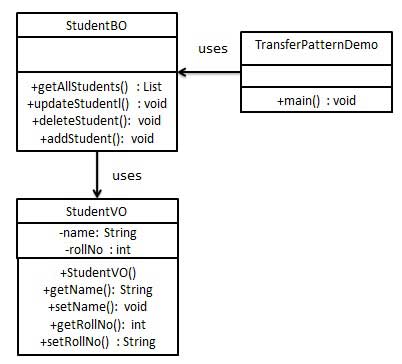傳輸對像模式
傳輸對像模式(Transfer Object Pattern)用於從客戶端向服務器一次性傳遞帶有多個屬性的數據。 傳輸對像也被稱為數值對象。 傳輸對像是一個具有getter/setter 方法的簡單的POJO 類,它是可序列化的,所以它可以通過網絡傳輸。 它沒有任何的行為。 服務器端的業務類通常從數據庫讀取數據,然後填充POJO,並把它發送到客戶端或按值傳遞它。 對於客戶端,傳輸對像是只讀的。 客戶端可以創建自己的傳輸對象,並把它傳遞給服務器,以便一次性更新數據庫中的數值。 以下是這種設計模式的實體。
- 業務對象(Business Object) -為傳輸對象填充數據的業務服務。
- 傳輸對象(Transfer Object) -簡單的POJO,只有設置/獲取屬性的方法。
- 客戶端(Client) -客戶端可以發送請求或者發送傳輸對像到業務對象。
實現
我們將創建一個作為業務對象的StudentBO和作為傳輸對象的StudentVO ,它們都代表了我們的實體。
TransferObjectPatternDemo,我們的演示類在這裡是作為一個客戶端,將使用StudentBO和Student來演示傳輸對象設計模式。

步驟1
創建傳輸對象。
StudentVO.java
public class StudentVO {
private String name;
private int rollNo;
StudentVO(String name, int rollNo){
this.name = name;
this.rollNo = rollNo;
}
public String getName() {
return name;
}
public void setName(String name) {
this.name = name;
}
public int getRollNo() {
return rollNo;
}
public void setRollNo(int rollNo) {
this.rollNo = rollNo;
}
}
步驟2
創建業務對象。
StudentBO.java
import java.util.ArrayList;
import java.util.List;
public class StudentBO {
//列表是當作一個數據庫List<StudentVO> students;
public StudentBO(){
students = new ArrayList<StudentVO>();
StudentVO student1 = new StudentVO("Robert",0);
StudentVO student2 = new StudentVO("John",1);
students.add(student1);
students.add(student2);
}
public void deleteStudent(StudentVO student) {
students.remove(student.getRollNo());
System.out.println("Student: Roll No "
+ student.getRollNo() +", deleted from database");
}
//從數據庫中檢索學生名單public List<StudentVO> getAllStudents() {
return students;
}
public StudentVO getStudent(int rollNo) {
return students.get(rollNo);
}
public void updateStudent(StudentVO student) {
students.get(student.getRollNo()).setName(student.getName());
System.out.println("Student: Roll No "
+ student.getRollNo() +", updated in the database");
}
}
步驟3
使用StudentBO來演示傳輸對象設計模式。
TransferObjectPatternDemo.java
public class TransferObjectPatternDemo {
public static void main(String[] args) {
StudentBO studentBusinessObject = new StudentBO();
//輸出所有的學生for (StudentVO student : studentBusinessObject.getAllStudents()) {
System.out.println("Student: [RollNo : "
+student.getRollNo()+", Name : "+student.getName()+" ]");
}
//更新學生StudentVO student =studentBusinessObject.getAllStudents().get(0);
student.setName("Michael");
studentBusinessObject.updateStudent(student);
//獲取學生studentBusinessObject.getStudent(0);
System.out.println("Student: [RollNo : "
+student.getRollNo()+", Name : "+student.getName()+" ]");
}
}
步驟4
驗證輸出。
Student: [RollNo : 0, Name : Robert ] Student: [RollNo : 1, Name : John ] Student: Roll No 0, updated in the database Student: [RollNo : 0, Name : Michael ]